VASCO DA GAMA - CONDE; ALMIRANTE E VICE-REI
(VASCO DA GAMA - Earl, Admiral and Viceroy: Also in English)
Se houve Portugueses que encheram este País de glória e elevaram o seu esplendor, sem dúvida Vasco da Gama foi um deles. Descobriu novas terras para o Império Português, aumentou-lhe as suas riquezas e no seu tempo foi o autor da maior viagem oceânica até então realizada, superior a uma volta ao mundo pelo equador.
Aqui tem revelados todos os antecedentes das viagens, as missões, a descoberta do caminho marítimo para as Indias, as relações diplomáticas com os povos, os confrontos com episódios dramáticos, as condecorações e a biografia do que foi um dos maiores descobridores Portugueses.
Esta publicação contém informação em Inglês, a qual tem mais gravuras e explicações adicionais. Pode ainda assistir a um magnífico documentário em Português, acerca de Vasco da Gama.
Texto: Português / Inglês
Áudio: Português
Fonte: Wikipédia - YouTube - RTP
Vasco da Gama - Em Português
| Vasco da Gama | |
|---|---|
| Vasco da Gama | |
| Vice-rei da Índia |
|
| Período de governo | 1524 |
| Antecessor(a) | Duarte de Menezes (1522 - 1524) |
| Sucessor(a) | Henrique de Menezes (1524 - 1526) |
| Vida | |
| Nascimento | 1460 ou 1469 Sines, Portugal |
| Morte | 24 de dezembro de 1524 Cochim, Estado Português da Índia |
| Dados pessoais | |
| Profissão | Almirante-mor |
| Assinatura |  |
Biografia
Juventude
Nasceu provavelmente em 14603 ou 14681 ou ainda 1469,4 5 em Sines,5 na costa sudoeste de Portugal, possivelmente numa casa perto da Igreja de Nossa Senhora das Salvas de Sines. Sines, um dos poucos portos da costa alentejana, era então uma pequena povoação habitada por pescadores.Era filho legítimo de Estêvão da Gama,1 que em 1460 era cavaleiro da casa de D. Fernando de Portugal, Duque de Viseu e Mestre da Ordem de Cristo.6 D. Fernando nomeara-o alcaide-mor de Sines e permitira-lhe receber uma pequena receita de impostos sobre a fabricação de sabão em Estremoz. Estêvão da Gama era casado com Dona Isabel Sodré, filha de João Sodré (também conhecido como João de Resende). Sodré, que era de ascendência Inglesa, tinha ligações à casa de D. Diogo, Duque de Viseu, filho de Fernando de Portugal, Duque de Viseu.7
Pouco se sabe do início da vida deste navegador. Foi sugerido pelo médico e historiador português Augusto Carlos Teixeira de Aragão, que terá estudado em Évora, onde poderá ter aprendido matemática e navegação. É evidente que conhecia bem a astronomia, e é possível que tenha estudado com o astrónomo Abraão Zacuto.8
Em 1492, João II de Portugal enviou-o ao porto de Setúbal, a sul de Lisboa, e ao Algarve para capturar navios franceses em retaliação por depredações feitas em tempo de paz contra a navegação portuguesa – uma tarefa que Vasco da Gama executou rápida e eficazmente.
Descoberta do caminho marítimo para a Índia (1497-1498)
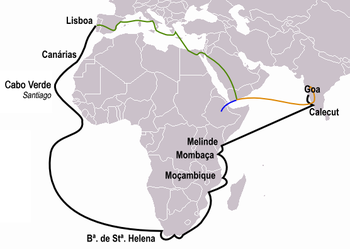
Viagem de Vasco da Gama (a preto) e as viagens anteriores de Pero da Covilhã (laranja) e Afonso de Paiva (azul), com o caminho percorrido antes de se separarem (a verde).
Quando Vasco da Gama tinha cerca de dez anos, esses planos de longo prazo estavam perto de ser concretizados: Bartolomeu Dias tinha retornado de dobrar o Cabo da Boa Esperança, depois de explorar o "Rio do Infante" (Great Fish River, na actual África do Sul) e após ter verificado que a costa desconhecida se estendia para o nordeste.
Em simultâneo foram feitas explorações por terra durante o reinado de D. João II de Portugal, suportando a teoria de que a Índia era acessível por mar a partir do Oceano Atlântico. Pero da Covilhã e Afonso de Paiva foram enviados via Barcelona, Nápoles e Rodes até Alexandria, porta para Aden, Ormuz e Índia.
Faltava apenas um navegador comprovar a ligação entre os achados de Bartolomeu Dias e os de Pero da Covilhã e Afonso de Paiva, para inaugurar uma rota de comércio potencialmente lucrativa para o Oceano Índico. A tarefa fora inicialmente atribuída por D. João II a Estevão da Gama, pai de Vasco da Gama. Contudo, dada a morte de ambos, em Julho de 1497 o comando da expedição foi delegado pelo novo rei D. Manuel I de Portugal a Vasco da Gama, possivelmente tendo em conta o seu desempenho ao proteger os interesses comerciais portugueses de depredações pelos franceses ao longo da Costa do Ouro Africana.
A chamada Primeira Armada da Índia seria financiada em parte pelo banqueiro florentino Girolamo Sernige.[carece de fontes]
A viagem
Era uma expedição essencialmente exploratória que levava cartas do rei D. Manuel I para os reinos a visitar, padrões para colocar, e que fora equipada por Bartolomeu Dias com alguns produtos que haviam provado ser úteis nas suas viagens, para as trocas com o comércio local. O único testemunho presencial da viagem é consta num diário de bordo anónimo, atribuído a Álvaro Velho:9
Contava com cerca de cento e setenta homens, entre marinheiros, soldados e religiosos, distribuídos por quatro embarcações:10
- São Gabriel, uma nau de 27 metros de comprimento e 178 toneladas, construída especialmente para esta viagem, comandada pelo próprio Vasco da Gama;
- São Rafael, de dimensões semelhantes à São Gabriel, também construída especialmente para esta viagem, comandada por Paulo da Gama, seu irmão; no regresso, com a tripulação diminuída, foi abatida em Melinde, prosseguindo na Bérrio e São Gabriel.
- Bérrio, uma nau ligeiramente menor que as anteriores, oferecida por D. Manuel de Bérrio, seu proprietário, sob o comando de Nicolau Coelho;
- São Miguel, uma nau para transporte de mantimentos, sob o comando de Gonçalo Nunes, que viria a ser queimada na ida, perto da baía de São Brás, na costa oriental africana.6
A 2 de Março de 1498, completando o contorno da costa africana, a armada chegou à costa de Moçambique, após haver sofrido fortes temporais e de Vasco da Gama ter sufocado com mão de ferro uma revolta da marinhagem. Na costa Leste Africana, os territórios controlados por muçulmanos integravam a rede de comércio no Oceano Índico. Em Moçambique encontram os primeiros mercadores indianos. Inicialmente são bem recebidos pelo sultão, que os confunde com muçulmanos e disponibiliza dois pilotos. Temendo que a população fosse hostil aos cristãos, tentam manter o equívoco mas, após uma série de mal entendidos, foram forçados por uma multidão hostil a fugir de Moçambique, e zarparam do porto disparando os seus canhões contra a cidade.12 13
O piloto que o sultão da ilha de Moçambique ofereceu para os conduzir à Índia havia sido secretamente incumbido de entregar os navios portugueses aos mouros em Mombaça. Um acaso fez descobrir a cilada e Vasco da Gama pôde continuar.
Em Fevereiro de 1498, Vasco da Gama seguiu para norte, desembarcando no amistoso porto de Melinde – rival de Mombaça – onde foi bem recebido pelo sultão que lhe forneceu um piloto árabe, conhecedor do Oceano Índico, cujo conhecimento dos ventos de monções permitiu guiar a expedição até Calecute, na costa sudoeste da Índia. As fontes divergem quanto à identidade do piloto, identificando-o por vezes como um cristão, um muçulmano e um guzerate. Uma história tradicional descreve o piloto como o famoso navegador árabe Ibn Majid, mas relatos contemporâneos posicionam Majid noutro local naquele momento.14
Chegada a Calecute
No dia seguinte à chegada, entre a multidão reunida na praia, foram saudados por dois mouros de Tunes (Tunísia), um dos quais dirigiu-se em castelhano «Ao diabo que te dou; quem te trouxe cá?». E perguntaram-lhe o que vínhamos buscar tão longe; e ele respondeu: «Vimos buscar cristãos e especiaria.», conforme relatado por Álvaro Velho. Ao ver as imagens de deuses Hindus Gama e os seus homens pensaram tratar-se de santos cristãos, por contraste com os muçulmanos que não tinham imagens. A crença nos "cristãos da Índia", como então lhes chamaram, perdurou algum tempo mesmo depois do regresso.16
Contudo, as negociações com o governador local, Samutiri Manavikraman Rajá, samorim de Calecute, foram difíceis. Os esforços de Vasco da Gama para obter condições comerciais favoráveis foram dificultados pela diferença de culturas e pelo baixo valor de suas mercadorias,17 com os representantes do samorim a escarnecerem das suas ofertas, e os mercadores árabes aí estabelecidos a resistir à possibilidade de concorrência indesejada. As mercadorias apresentadas pelos portugueses mostraram-se insuficientes para impressionar o samorim, em comparação com os bens de alto valor ali comerciados, o que gerou alguma desconfiança. Os portugueses acabariam por vender as suas mercadorias por baixo preço para poderem comprar pequenas quantidades de especiarias e jóias para levar para o reino.
Por fim o samorim mostrou-se agradado com as cartas de D. Manuel I e Vasco da Gama conseguiu obter uma carta ambígua de concessão de direitos para comerciar, mas acabou por partir sem aviso após o Samorim e o seu chefe da Marinha Kunjali Marakkar insistirem para que deixasse todos os seus bens como garantia. Vasco da Gama manteve os seus bens, mas deixou alguns portugueses com ordens para iniciar uma feitoria.
Regresso a Portugal
Vasco da Gama iniciou a viagem de regresso a 29 de Agosto de 1498. Na ânsia de partir, ignorou o conhecimento local sobre os padrões da monção que lhe permitiria velejar. Na Ilha de Angediva foram abordados por um homem que se afirmava cristão mas que se fingia de muçulmano ao serviço de Hidalcão, o sultão de Bijapur. Suspeitando que era um espião, açoitaram-no até que ele confessou ser um aventureiro judeu polaco no Oriente. Vasco da Gama apadrinhou-o, nomeando-o Gaspar da Gama.Na viagem de ida, cruzar o Índico até à Índia com o auxílio dos ventos de monção demorara apenas 23 dias. A de regresso, navegando contra o vento, consumiu 132 dias, tendo as embarcações aportado em Melinde a 7 de Janeiro de 1499. Nesta viagem cerca de metade da tripulação sobrevivente pereceu, e muitos dos restantes foram severamente atingidos pelo escorbuto, por isso dos 148 homens que integravam a armada, só 55 regressaram a Portugal. Apenas duas das embarcações que partiram do Tejo conseguiram voltar a Portugal, chegando, respectivamente em Julho e Agosto de 1499.18 A caravela Bérrio, sendo a mais leve e rápida da frota, foi a primeira a regressar a Lisboa, onde aportou a 10 de Julho de 1499, sob o comando de Nicolau Coelho e tendo como piloto Pêro Escobar, que mais tarde acompanhariam a frota de Pedro Álvares Cabral na viagem em que se registrou o descobrimento do Brasil em Abril de 1500.
Vasco da Gama regressou a Portugal em Setembro de 1499, um mês depois de seus companheiros, pois teve de sepultar o irmão mais velho Paulo da Gama, que adoecera e acabara por falecer na ilha Terceira, nos Açores. No seu regresso, foi recompensado como o homem que finalizara um plano que levara oitenta anos a cumprir. Recebeu o título de "almirante-mor dos Mares das Índia",19 sendo-lhe concedida uma renda de trezentos mil réis anuais, que passaria para os filhos que tivesse. Recebeu ainda, conjuntamente com os irmãos, o título perpétuo de Dom e duas vilas, Sines e Vila Nova de Milfontes.20
Segunda viagem à Índia (1502)
A 12 de Fevereiro de 1502, Vasco da Gama comandou nova expedição com uma frota de vinte navios de guerra, com o objetivo de fazer cumprir os interesses portugueses no Oriente. Fora convidado após a recusa de Pedro Álvares Cabral, que se desentendera com o monarca acerca do comando da expedição. Esta viagem ocorreu depois da segunda armada à Índia, comandada por Pedro Álvares Cabral em 1500, que ao desviar-se da rota descobrira o Brasil. Quando chegou à Índia, Cabral soube que os portugueses que haviam sido aí deixados por Vasco da Gama na primeira viagem para estabelecer um posto comercial haviam sido mortos. Após bombardear Calecute, rumou para o sul até Cochim, um pequeno reino rival, onde foi calorosamente recebido pelo Rajá, regressando à Europa com seda e ouro.Gama tomou e exigiu um tributo à ilha de Quíloa na África Oriental, um dos portos de domínio árabe que haviam combatido os portugueses, tornando-a tributária de Portugal. Com ouro proveniente de 500 moedas trazidas por Vasco da Gama do régulo de Quíloa (actual Kilwa Kisiwani, na Tanzânia), como tributo de vassalagem ao rei de Portugal, foi mandada criar, pelo rei D. Manuel I para o Mosteiro dos Jerónimos, a Custódia de Belém.
Nesta viagem ocorreu o primeiro registo europeu conhecido do avistamento das ilhas Seychelles, que Vasco da Gama nomeou Ilhas Amirante (ilhas do Almirante) em sua própria honra.
Vasco da Gama partira com o objectivo de instalar o centro português e uma feitoria em Cochim, após esforços consecutivos de Pedro Álvares Cabral e João da Nova. Bombardeou Calecute e destruiu postos de comércio árabes.
Depois de chegar ao norte do Oceano Índico, Vasco da Gama aguardou até capturar um navio que retornava de Meca, o Mîrî, com importantes mercadores muçulmanos, apreendendo todas as mercadorias e incendiando-o.21 Ao chegar a Calecute, a 30 de Outubro 1502, o samorim estava disposto a assinar um tratado,22 num acto de ferocidade que chocou até os cronistas contemporâneos, que o consideraram um acto e vingança pelos portugueses mortos em Calecute da sua primeira viagem.
Em 1 de Março de 1503 inicia-se a guerra entre o samorim de Calecute e o rajá de Cochim. Os seus navios assaltaram navios mercantes árabes, destruindo também uma frota de 29 navios de Calecute. Após essa batalha, obteve então concessões comerciais favoráveis do Samorim. Vasco da Gama fundou a colónia portuguesa de Cochim, na Índia, regressando a Portugal em Setembro de 1503. Vasco da Gama voltou a pátria em 1513 e levou vida retirada, em Évora, apesar da consideração de que gozava junto do rei5 .
Terceira viagem à Índia (1524)
Em 1519 foi feito primeiro Conde da Vidigueira5 pelo rei D. Manuel I, com sede num terreno comprado a D. Jaime I, Duque de Bragança, que a 4 de Novembro cedera as vilas da Vidigueira e Vila de Frades a Vasco da Gama, seus herdeiros e sucessores, bem como todos os rendimentos e privilégios relacionados,23 sendo o primeiro Conde português sem sangue real.Tendo adquirido uma reputação de temível "solucionador" de problemas na Índia, Vasco da Gama foi enviado de novo para o subcontinente indiano em 1524.1 5 O objectivo era o de que ele substituísse o Duarte de Meneses, cujo governo se revelava desastroso, mas Vasco da Gama contraiu malária pouco depois de chegar a Goa. Como vice-rei atuou com rigidez e conseguiu impor a ordem,1 mas veio a falecer na cidade de Cochim, na véspera de Natal em 1524.5
Aqui estiveram até 1880, data em que ocorreu a trasladação para o Mosteiro dos Jerónimos,24 que foram construídos logo após a sua viagem, com os primeiros lucros do comércio de especiarias, ficando ao lado do túmulo de Luís Vaz de Camões. Há quem defenda, porém, que os ossos de Vasco da Gama ainda se encontram na vila alentejana. Como testemunho da trasladação das ossadas, em frente à estátua do navegador na Vidigueira, existe a antiga Escola Primária Vasco da Gama (cuja construção serviu de moeda de troca para obter permissão para efectuar a trasladação à época), onde se encontra instalado o Museu Municipal de Vidigueira.
Títulos e honrarias
Foi feito:- Conde da Vidigueira em 1519 pelo Rei D. Manuel I de Portugal;
- Almirante dos mares da Índia;
- Segundo Vice-Rei da Índia em 1524.
Legado
Embora o rei D. Manuel tenha compreendido a importância das suas mercadorias, apesar de escassas, as conquistas de Vasco da Gama foram um pouco obscurecidas pelo seu fracasso em trazer bens comerciais de interesse para as nações da Índia. Além disso, a rota de mar estava repleta de perigos – a sua frota levou mais de trinta dias sem ver terra e apenas 60 dos seus 180 companheiros, numa das suas três naus, regressaram a Portugal em 1498. No entanto, esta jornada abriu a rota do cabo direta para a Ásia.
Na segunda armada à Índia, de Pedro Álvares Cabral, seria feita uma demonstração de poder, com tripulação dez vezes maior e 9 navios a mais.
Da sua esposa, D. Catarina de Ataíde, Vasco da Gama teve sete filhos. Alguns acompanharam-no e vieram a desempenhar importantes cargos no Oriente: Francisco, segundo Conde da Vidigueira; Estêvão, 11º governador da Índia; Paulo; Cristóvão, um mártir na Etiópia; Pedro, Isabel de Ataíde e Álvaro da Gama, Capitão de Malaca.25
O poema épico "Os Lusíadas" (1572) de Luís Vaz de Camões, centra-se em grande parte nas viagens de Vasco da Gama. José Agostinho de Macedo escreveu o poema narrativo "Gama" (1811),26 posteriormente refundido e aperfeiçoado no poema épico "O Oriente" (1814),27 com Vasco da Gama como Herói.28 A ópera "L'Africaine", composta em 1865 por Giacomo Meyerbeer e Eugène Scribe, inclui a personagem de Vasco da Gama, interpretada em 1989 na San Francisco Opera pelo tenor Placido Domingo. O compositor do século XIX, Louis-Albert Bourgault-Ducoudray, compôs uma ópera em 1872 de mesmo nome, baseada na vida e explorações marítimas de Vasco da Gama. A cidade portuária de Vasco da Gama, em Goa, é nomeada em sua memória, como o é a "cratera de Vasco da Gama" na Lua. Existem três clubes de futebol no Brasil (incluindo o Club de Regatas Vasco da Gama) e o Vasco Sports Club, em Goa, também nomeados em sua homenagem. Uma igreja em Cochim, Kerala, a Igreja Vasco da Gama, e o bairro Vasco na Cidade do Cabo, também o homenageiam.
DOCUMENTÁRIO:
GRANDES PORTUGUESES :
VASCO DA GAMA
Vasco da Gama - In English
| Vasco da Gama | |||||
|---|---|---|---|---|---|
| Admiral of the Seas of Arabia, Persia, India and all the Orients (more...) | |||||
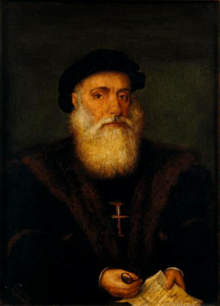 |
|||||
| Count of Vidigueira | |||||
| Tenure | 29 December 1519 – 23 December 1524 |
||||
| Successor | Francisco da Gama | ||||
| Spouse | Catarina de Ataíde | ||||
| Issue Among others |
D. Francisco da Gama, 2nd Count of Vidigueira D. Estêvão da Gama, Viceroy of India D. Cristóvão da Gama, Captain of Malacca |
||||
|
|||||
| Father | Estêvão da Gama | ||||
| Mother | Isabel Sodré | ||||
| Born | 1460 or 1469 Sines or Vidigueira, Alentejo, Kingdom of Portugal |
||||
| Died | 23 December 1524 (aged c. 55–65) Kochi, Portuguese India |
||||
| Burial | Jerónimos Monastery, Lisbon, Kingdom of Portugal | ||||
| Occupation | Explorer, Viceroy of India | ||||
| Signature |  |
||||
This discovery was significant and opened the way for an age of global imperialism and for the Portuguese to establish a long-lasting colonial empire in Asia. The route meant that the Portuguese would not need to cross the highly disputed Mediterranean nor the dangerous Arabian Peninsula, and that the whole voyage would be made by sea. The sum of the distances covered in the outward and return voyages made this expedition the longest ocean voyage ever made until then, far longer than a full voyage around the world by way of the Equator.[1]
One century after the discovery, European powers such as England, the Netherlands and France were finally able to challenge and break Portugal's monopoly and naval supremacy in the Cape Route around Africa, the Indian ocean and in the Far East, opening a new era of European imperialism in the East.
After decades of sailors trying to reach the Indies with thousands of lives and dozens of vessels lost in shipwrecks and attacks, da Gama landed in Calicut on 20 May 1498. Reaching the legendary Indian spice routes unopposed helped the Portuguese Empire improve its economy that, until da Gama's discovery, was based mainly on trading along northern and coastal West Africa. The spices obtained were mostly pepper and cinnamon at first, but soon included other products, all new to Europe and leading to a commercial monopoly for several decades.
Da Gama led two of the armadas destined for India, the first and the fourth, which was the largest and made only four years after his return from the first one. For his contributions he was appointed the Governor of India in 1524, under the title of Viceroy, and given the newly created County of Vidigueira in 1519. Vasco da Gama remains a leading figure in the history of exploration to this day. Numerous homages have been made worldwide to celebrate his explorations and accomplishments. The Portuguese national epic, Os Lusíadas, was written in his honour. His first trip to India is widely considered a milestone in world history as it marked the beginning of the first wave of global multiculturalism.[2]
Early life
Vasco da Gama's father was Estêvão da Gama, who had served in the 1460s as a knight of the household of Infante Ferdinand, Duke of Viseu[4] and went on to rise in the ranks of the military Order of Santiago. Estêvão da Gama was appointed alcaide-mór (civil governor) of Sines in the 1460s, a post he held until 1478, and continued as a receiver of taxes and holder of the Order's commendas in the region.
Estêvão da Gama married Isabel Sodré, a daughter of João Sodré (also known as João de Resende), scion of a well-connected family of English origin.[5] Her father and her brothers, Vicente Sodré and Brás Sodré, had links to the household of Infante Diogo, Duke of Viseu and were prominent figures in the military Order of Christ.
Vasco da Gama was the third of five sons of Estêvão da Gama and Isabel Sodré – in (probable) order of age: Paulo da Gama, João Sodré, Vasco da Gama, Pedro da Gama and Aires da Gama. Vasco also had one known sister, Teresa da Gama (who married Lopo Mendes de Vasconcelos).[6]
Little is known of da Gama's early life. The Portuguese historian Teixeira de Aragão suggests that he studied at the inland town of Évora, which is where he may have learned mathematics and navigation and it has even been claimed (although dubiously) that he studied under the astronomer Abraham Zacuto.[7]
Around 1480, da Gama followed his father (rather than the Sodrés) and joined the Order of Santiago.[8] The master of Santiago was Prince John, who would ascend to the throne in 1481 as King John II of Portugal. John II doted on the Order, and the da Gamas' prospects rose accordingly.
In 1492, John II dispatched da Gama on a mission to the port of Setúbal and to the Algarve to seize French ships in retaliation for peacetime depredations against Portuguese shipping – a task that da Gama rapidly and effectively performed.[9]
Exploration before da Gama
It remained for an explorer to prove the link between the findings of Dias and those of da Covilhã and de Paiva and to connect these separate segments into a potentially lucrative trade route into the Indian Ocean. The task, originally given to Vasco da Gama's father, was finally offered to Vasco by Manuel I on the strength of his record of protecting Portuguese trading stations along the African Gold Coast from depredations by the French.
First voyage
| It has been suggested that Discovery of the sea route to India be merged into this article. (Discuss) Proposed since August 2012. |
- The São Gabriel, commanded by Vasco da Gama; a carrack of 178 tons, length 27 m, width 8.5 m, draft 2.3 m, sails of 372 m²
- The São Rafael, whose commander was his brother Paulo da Gama; similar dimensions to the São Gabriel
- The caravel Berrio, slightly smaller than the former two (later renamed São Miguel), commanded by Nicolau Coelho
- A storage ship of unknown name, commanded by Gonçalo Nunes, later lost near the Bay of São Brás, along the east coast of Africa[4]
Journey to the Cape
The expedition set sail from Lisbon on 8 July 1497. It followed the route pioneered by earlier explorers along the coast of Africa via Tenerife and the Cape Verde Islands. After reaching the coast of present day Sierra Leone, da Gama took a course south into the open ocean, crossing the Equator and seeking the South Atlantic westerlies that Bartolomeu Dias had discovered in 1487.[12] This course proved successful and on 4 November 1497, the expedition made landfall on the African coast. For over three months the ships had sailed more than 6,000 miles of open ocean, by far the longest journey out of sight of land made by that time.[10][13]Mozambique
Vasco da Gama spent 2 to 29 March 1498 in the vicinity of Mozambique Island. Arab-controlled territory on the East African coast was an integral part of the network of trade in the Indian Ocean. Fearing the local population would be hostile to Christians, da Gama impersonated a Muslim and gained audience with the Sultan of Mozambique. With the paltry trade goods he had to offer, da Gama was unable to provide a suitable gift to the ruler and soon the local populace became suspicious of da Gama and his men. Forced by a hostile crowd to flee Mozambique, da Gama departed the harbor, firing his cannons into the city in retaliation.[14]Mombasa
In the vicinity of modern Kenya, the expedition resorted to piracy, looting Arab merchant ships – generally unarmed trading vessels without heavy cannons. The Portuguese became the first known Europeans to visit the port of Mombasa 7th to 13 April 1498, but were met with hostility and soon departed.Malindi
Vasco da Gama continued north, arriving at the friendlier port of Malindi on 14 April 1498 – whose leaders were then in conflict with those of Mombasa – and there the expedition first noted evidence of Indian traders. Da Gama and his crew contracted the services of a pilot whose knowledge of the monsoon winds allowed him to bring the expedition the rest of the way to Calicut, located on the southwest coast of India. Sources differ over the identity of the pilot, calling him variously a Christian, a Muslim, and a Gujarati. One traditional story describes the pilot as the famous Arab navigator Ibn Majid, but other contemporaneous accounts place Majid elsewhere, and he could not have been near the vicinity at the time.[15] Also, none of the Portuguese historians of the time mention Ibn Majid. Vasco da Gama left Malindi for India on 24 April 1498.Calicut, India
Return
Vasco da Gama left Calicut on 29 August 1498. Eager to set sail for home, he ignored the local knowledge of monsoon wind patterns which were still blowing onshore. The fleet initially inched north along the Indian coast, and then anchored in at Anjediva island for a spell. They finally struck out for their Indian Ocean crossing on 3 October 1498. But with the winter monsoon yet to set in, it was a harrowing journey. On the outgoing journey, sailing with the summer monsoon wind, it had taken Gama's fleet only 23 days to cross the Indian Ocean; now, on the return trip, sailing against the wind, it took 132 days.Vasco da Gama saw land again only on 2 January 1499, alighting before the coastal Somali city of Mogadishu, then under the influence of the Ajuran Empire in the Horn of Africa. They did not make a stop, but passing before Mogadishu, the anonymous diarist of the expedition noted that it was a large city with houses of four or five storeys high and big palaces in its center and many mosques with cylindrical minarets.[18]
Vasco da Gama's fleet finally arrived in Malindi on 7 January 1499, in a terrible shape – approximately half of the crew had died during the crossing, and many of the rest were afflicted with scurvy. Not having enough crewmen left standing to manage three ships, Vasco da Gama ordered the São Rafael scuttled off the East African coast, and the crew re-distributed to the remaining two ships, the São Gabriel and the Berrio. Thereafter, the sailing was smoother. By early March, they had arrived in Mossel Bay, and crossed the Cape of Good Hope in the opposite direction on 20 March. They reached the west African coast by 25 April.
The spice trade would prove to be a major asset to the Portuguese royal treasury, and other consequences soon followed. For example, Gama's voyage had made it clear that the east coast of Africa, the Contra Costa, was essential to Portuguese interests; its ports provided fresh water, provisions, timber, and harbors for repairs, and served as a refuge where ships could wait out unfavorable weather. One significant result was the colonization of Mozambique by the Portuguese Crown.
Rewards
In December 1499, Vasco da Gama was rewarded by King Manuel I of Portugal with the town of Sines as a hereditary fief (the very town which his father, Estêvão, had once held as a commenda). This turned out to be a rather complicated affair, for Sines still belonged to the Order of Santiago. On the face of it, it should not have been a problem for Jorge de Lencastre, the master of the Order, to endorse the reward – after all, Gama was a Santiago knight, one of their own, and a close associate of Lencastre himself. But the fact that Sines was awarded by the king's hand, provoked Lencastre to refuse out of principle – lest it encourage the king to make other donations of the Order's properties.[21] Gama would spend the next few years attempting to take hold of Sines – an effort which would estrange him from Lencastre and eventually prompt Gama to abandon his beloved Order of Santiago, switching over to the rival Order of Christ in 1507.In the meantime, Gama made do with a substantial hereditary royal pension of 300,000 reis. He was awarded the noble title of Dom (lord) in perpetuity for himself, his siblings and their descendants. On 30 January 1502, Vasco da Gama was awarded the title of Almirante dos mares de Arabia, Persia, India e de todo o Oriente ("Admiral of the Seas of Arabia, Persia, India and all the Orient") – an overwrought title reminiscent of the ornate Castilian title borne by Christopher Columbus (evidently, Manuel must have reckoned that if Castile had an 'Admiral of the Ocean Seas' running around, then surely Portugal should have one too.)[22] Another royal letter, dated October 1501, gave Vasco da Gama the personal right to intervene and exercise a determining role on any future India-bound fleet.
Around 1501, Vasco da Gama married Catarina de Ataíde, daughter of Álvaro de Ataíde, the alcaide-mór of Alvor (Algarve), and a prominent nobleman connected by kinship with the powerful Almeida family (Catarina was a first cousin of D. Francisco de Almeida).[23]
Second voyage
Main article: 4th Portuguese India Armada (Gama, 1502)
Vasco da Gama invoked his royal letter to take command of the 4th India Armada, scheduled to set out in 1502, with the explicit aim of taking revenge upon the Zamorin and force him to submit to Portuguese terms. The heavily armed fleet of fifteen ships and eight hundred men left Lisbon on 12 February 1502. It was followed in April by another squadron of five ships led by his cousin, Estêvão da Gama (the son of Aires da Gama), which caught up to them in the Indian Ocean. The 4th Armada was a veritable Gama family affair. Two of his maternal uncles, Vicente Sodré and Brás Sodré, were pre-designated to command an Indian Ocean naval patrol, while brothers-in-law D. Álvaro de Ataíde (brother of Vasco's wife Catarina) and Lopo Mendes de Vasconcelos (betrothed to Teresa da Gama, Vasco's sister) captained ships in the main fleet.
Along the way, on the outgoing voyage, Gama's fleet opened contact with the East African gold trading port of Sofala, and reduced the sultanate of Kilwa to tribute, extracting a substantial sum of gold. On reaching India in October 1502, Gama's fleet set about capturing any Arab vessel he came across in Indian waters, most notoriously the Miri, a pilgrim ship from Mecca, whose passengers he had massacred in open water.[24] He then appeared before Calicut, demanding redress for the treatment meted out to Cabral. While the Zamorin was willing to sign a new treaty,[25] Da Gama made a preposterous call to the Hindu king to expel all Muslims from Calicut before beginning negotiations, which was naturally turned down. The Portuguese fleet then bombarded the city for nearly two days from the sea shore, severely damaging the unfortified city. He also captured several rice vessels and barbarously cut off the crew's hands, ears and noses, dispatching them with an insulting note to the Zamorin.[26]
The violent treatment meted out by da Gama quickly brought trade along the Malabar Coast of India, upon which Calicut depended, to a standstill. But the Zamorin nonetheless refused to submit to Portuguese terms, and even ventured to hire a fleet of strong warships to challenge da Gama's armada (which da Gama managed to defeat in a naval battle before Calicut harbor). Da Gama loaded up with spices at Cochin and Cannanore, small nearby kingdoms, half-vassal and half-at-war with the Zamorin, whose alliances had been secured by prior Portuguese fleets. The 4th armada left India in early 1503. Da Gama left behind a small squadron of caravels, under the command of his uncle, Vicente Sodré, to patrol the Indian coast, continue harassing Calicut shipping and protect the Portuguese factories at Cochin and Cannanore from the Zamorin's inevitable reprisals.
Vasco da Gama arrived back in Portugal in September 1503, effectively having failed in his mission to bring the Zamorin to submission. This failure, and the subsequent more galling failure of his uncle Vicente Sodré to protect the Portuguese factory in Cochin, probably counted against any further rewards. When the Portuguese king Manuel I of Portugal decided to appoint the first governor and viceroy of Portuguese India in 1505, da Gama was conspicuously overlooked, and the post given to D. Francisco de Almeida.
Pilgrim ship incident
On his second voyage, Vasco da Gama inflicted acts of cruelty upon competing traders and local inhabitants, which sealed his notoriety in India.[27][28] During his second voyage to Calicut, da Gama intercepted a ship of Muslim pilgrims at Madayi travelling from Calicut to Mecca. Described in detail by eyewitness Thomé Lopes and chronicler Gaspar Correia as one that is unequalled in cold-blooded cruelty, da Gama looted the ship with over 400 pilgrims on board including 50 women, locked in the passengers, the owner and an ambassador from Egypt and burnt them to death. They offered their wealth which 'could ransom all the Christian slaves in the Kingdom of Fez and much more' but were not spared. Da Gama looked on through the porthole and saw the women bringing up their gold and jewels and holding up their babies to beg for mercy.'[29]After demanding the expulsion of Muslims from Calicut to the Hindu Zamorin, the latter sent the high priest Talappana Namboothiri (the very same person who conducted da Gama to the Zamorin's chamber during his much celebrated first visit to Calicut in May 1498) for talks. Da Gama called him a spy, ordered the priests' lips and ears to be cut off and after sewing a pair of dog's ears to his head, sent him away.[27]
Interlude
After Ferdinand Magellan defected to the Crown of Castile in 1518, Vasco da Gama threatened to do the same, prompting the king to undertake steps to retain him in Portugal and avoid the embarrassment of losing his own "Admiral of the Indies" to Spain.[30] In 1519, after years of ignoring his petitions, King Manuel I finally hurried to give Vasco da Gama a feudal title, appointing him the first Count of Vidigueira, a count title created by a royal decree issued in Évora on 29 December, after a complicated agreement with Dom Jaime, Duke of Braganza, who ceded him on payment the towns of Vidigueira and Vila dos Frades. The decree granted Vasco da Gama and his heirs all the revenues and privileges related,[31] thus establishing da Gama as the first Portuguese count who was not born with royal blood.[32]
Third voyage
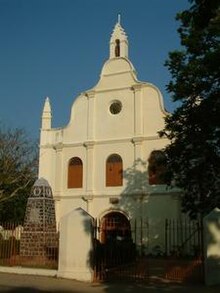
St. Francis CSI Church, in Kochi. Vasco da Gama, died in Kochi in 1524 when he was on his third visit to India. His body was originally buried in this church.
By his appointment letter of February 1524, John III granted Vasco da Gama the privileged title of "Viceroy", being only the second Portuguese governor to enjoy that title (the first was Francisco de Almeida in 1505).[33] His second son, Estêvão da Gama was simultaneously appointed Capitão-mor do Mar da Índia ('Captain-major of the Indian Sea', commander of the Indian Ocean naval patrol fleet), to replace Duarte's brother, Luís de Menezes. As a final condition, Gama secured from John III of Portugal the commitment to appoint all his sons successively as Portuguese captains of Malacca.
Setting out in April 1524, with a fleet of fourteen ships, Vasco da Gama took as his flagship the famous large carrack Santa Catarina do Monte Sinai on her last journey to India, along with two of his sons, Estêvão and Paulo. After a troubled journey (four or five of the ships were lost en route), he arrived in India in September. Vasco da Gama immediately invoked his high viceregent powers to impose a new order in Portuguese India, replacing all the old officials with his own appointments. But Gama contracted malaria not long after arriving, and died in the city of Cochin on Christmas Eve in 1524, three months after his arrival. As per royal instructions, da Gama was succeeded as governor of India by one the captains who had come with him, Henrique de Menezes (no relation to Duarte). Vasco's sons Estêvão and Paulo immediately lost their posts and joined the returning fleet of early 1525 (along with the dismissed Duarte de Menezes and Luís de Menezes).[34]
Vasco da Gama's body was first buried at St. Francis Church, which was located at Fort Kochi in the city of Kochi, but his remains were returned to Portugal in 1539. The body of Vasco da Gama was re-interred in Vidigueira in a casket decorated with gold and jewels.
Ancestry
| [show]Ancestors of Vasco da Gama |
|---|
Marriage and issue
Vasco da Gama and his wife, Catarina de Ataíde, had six sons and one daughter:[35]- Dom Francisco da Gama, who inherited his father's titles as 2nd Count of Vidigueira and the 2nd "Admiral of the Seas of India, Arabia and Persia". He remained in Portugal.
- Dom Estevão da Gama, after his abortive 1524 term as Indian patrol captain, he was appointed for a three-year term as captain of Malacca, serving from 1534 to 1539 (includes the last two years of his brother Paulo's term). He was subsequently appointed as the 11th governor of India from 1540 to 1542.
- Dom Paulo da Gama, captain of Malacca in 1533–34, killed in a naval action off Malacca.
- Dom Cristovão da Gama, captain of Malacca fleet from 1538 to 1540; nominated to succeed in Malacca, but executed by Ahmad ibn Ibrahim during the Ethiopian-Adal war in 1542.
- Dom Pedro da Silva da Gama, appointed captain of Malacca from 1548 to 1552.
- Dom Álvaro d'Ataide da Gama appointed captain of Malacca fleet in the 1540s, captain of Malacca itself from 1552 to 1554.
- Dona Isabel d'Ataide da Gama, only daughter, married Ignacio de Noronha, son of the first Count of Linhares.
Titles, styles, and honours
Over his numerous years serving the Portuguese crown, da Gama was rewarded with many different titles, distinctions, and offices:- Admiral of the Seas of Arabia, Persia, India and all the Orient – Title as chief of the Portuguese India Armadas
- 2nd Viceroy of India – Title of office as colonial head of Portuguese India
- 1st Count of Vidigueira – Title of Portuguese nobility
Legacy
Vasco da Gama is one of the most famous and celebrated explorers from the Age of Discovery. As much as anyone after Henry the Navigator, he was responsible for Portugal's success as an early colonising power. Beside the fact of the first voyage itself, it was his astute mix of politics and war on the other side of the world that placed Portugal in a prominent position in Indian Ocean trade. Following da Gama's initial voyage, the Portuguese crown realized that securing outposts on the eastern coast of Africa would prove vital to maintaining national trade routes to the Far East.The Portuguese national epic, the Lusíadas of Luís Vaz de Camões, largely concerns Vasco da Gama's voyages.[36]
The 1865 grand opera L'Africaine: Opéra en Cinq Actes, composed by Giacomo Meyerbeer from a libretto by Eugène Scribe, prominently includes the character of Vasco da Gama. The events depicted, however, are fictitious. Meyerbeer's working title for the opera was Vasco da Gama. A 1989 production of the opera by the San Francisco Opera featured noted tenor Plácido Domingo in the role of da Gama.[37] The 19th-century composer Louis-Albert Bourgault-Ducoudray composed an eponymous 1872 opera based on da Gama's life and exploits at sea.
The port city of Vasco da Gama in Goa is named after him, as is the crater Vasco da Gama on the Moon. There are three football clubs in Brazil (including Club de Regatas Vasco da Gama) and Vasco Sports Club in Goa that were also named after him. There exists a church in Kochi, Kerala called Vasco da Gama Church, and a private residence on the island of Saint Helena. The suburb of Vasco in Cape Town also honours him.
Vasco da Gama was the only explorer on the final pool of Os Grandes Portugueses. Although the final shortlist featured other Age of Discovery related people, they were not actually explorers nor navigators for any matter.
The Portuguese Navy has a class of frigates named after him. There are three Vasco da Gama class frigates in total, of which the first one also bears his name.
South African musician Hugh Masekela recorded an anti-colonialist song entitled "Vasco da Gama (The Sailor Man)", which contains the lyrics "Vasco da Gama was no friend of mine". He later recorded another version of this song under the name "Colonial Man".
Vasco da Gama appears as an antagonist in the Indian film Urumi. The film, directed by acclaimed cinematographer Santosh Sivan, depicts a failed assassination attempt on da Gama by an Indian.

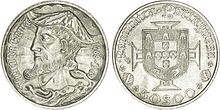

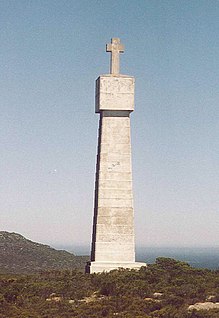

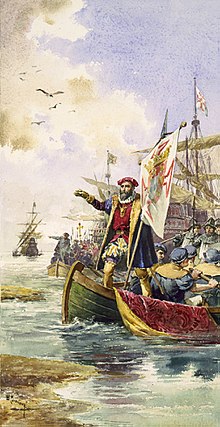
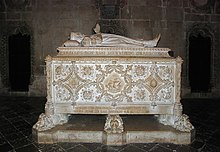


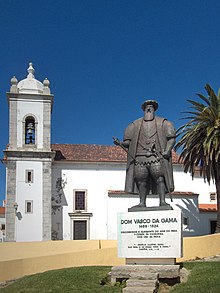

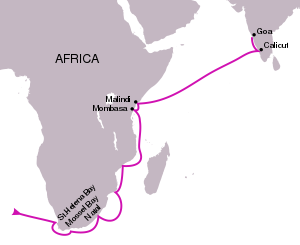

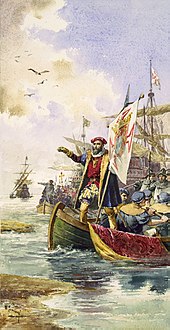
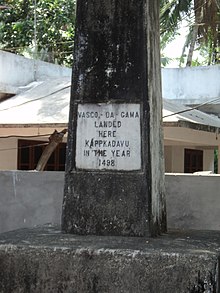

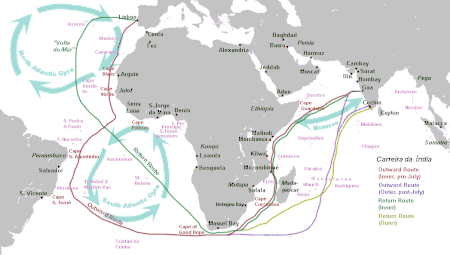




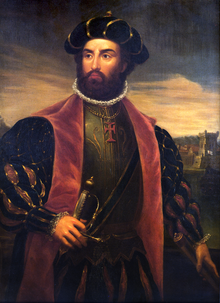

Sem comentários:
Enviar um comentário